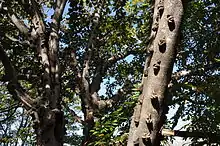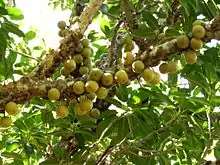Ficus sansibarica
The Knobbly fig (Ficus sansibarica) is an African species of cauliflorous fig. It is named after Zanzibar, where Franz Stuhlmann discovered it in 1889.[3] They often begin life as epiphytes, which assume a strangling habit as they develop.[4] They regularly reach 10 m, but may grow up to 40 m tall as forest stranglers.[1]
| Knobbly fig | |
|---|---|
 | |
 | |
| The nominate subsp. in the Kruger Park | |
| Scientific classification | |
| Kingdom: | |
| (unranked): | |
| (unranked): | |
| (unranked): | |
| Order: | |
| Family: | |
| Genus: | |
| Species: | F. sansibarica |
| Binomial name | |
| Ficus sansibarica Warb. 1894 | |
| Synonyms | |
Range and habitat
It occurs in the African tropics and subtropics from coastal elevations to 900 m above sea level.[5] The nominate subspecies has an easterly distribution, but extends westwards up the Zambezi Valley.[6]
They are found in coastal, riverine and evergreen forests or woodland, and in miombo woodlands. They are locally cultivated in parks,[6] villages[4] or bush camps. They prefer deep sandy soil and often start life as a strangler.[7][8] The pollinating wasp is Courtella armata.[5]
Description
The light grey bark is fairly smooth, though lumpy and folded.[1] The smooth leaves are up to 13 cm long and oblong-obovate.[8] They have parallel sides and are carried on slender petioles.[1]
The large (up to 5 cm), bitter-tasting figs appear in groups of 2 or 3 during the summer months.[1] They are cauliflorous, growing on the characteristic wart-like, leafless branchlets on the trunk and main branches (i.e. old wood).[7]
F. chirindensis of the forests of southeastern Zimbabwe and adjacent Mozambique is similar, but has the leaves more oval, often has buttress roots,[7] and bears the small (1.5 cm) figs in stalked pairs on second year branches.[1]
Uses
The raw figs are used for food, and are locally believed to promote fertility. Stems are torn apart to obtain fibers for basket weaving.[4] Locally it is also deemed sacred.
Subspecies and status
- F. s. subsp. sansibarica – East Africa: southern Kenya, Tanzania, Malawi, Zambia, northern Botswana, Zimbabwe, Mozambique, northeastern South Africa and Swaziland
- F. s. subsp. macrosperma (Warb. ex Mildbr. & Burret) C.C.Berg – West and Central Africa: Senegal to DRC, Uganda and Angola
The species is deemed critically endangered in Swaziland, where most are located in proposed sugar cane expansion areas near Sihoye.[9] On Inhaca Island however, it is held sacred by most communities, and is scrupulously protected.[3]
Gallery
_(11498807685).jpg.webp) Foliage
Foliage%252C_Kruger_National_Park%252C_South_Africa_(29208468275).jpg.webp) Figs on wart-like branchlets
Figs on wart-like branchlets_fruits_(11498883455).jpg.webp) Figs carried on spurs
Figs carried on spurs
References
- Palgrave, K.C. (1984). Trees of Southern Africa. Cape Town: Struik. pp. 114–115. ISBN 0-86977-081-0.
- "Ficus sansibarica Warb". The Plant List. Version 1. 2010. Retrieved 5 July 2013.
- Mtsweni, Patrick. "Ficus sansibarica Warb". PlantZAfrica.com. SANBI. Retrieved 24 July 2013.
- Fern, Ken (2019). "Ficus sansibarica Warb. Moraceae". Tropical Plants Database. tropical.theferns.info. Retrieved 31 May 2019.
- Van Noort; et al. "Ficus sansibarica sansibarica Warburg 1894". Figweb. iziko museums. Archived from the original on 30 November 2012. Retrieved 7 January 2012.
- Berg, C. C. (1991). "Ficus sansibarica subsp. sansibarica [family MORACEAE]". Flora Zambesiaca. JSTOR Global Plants. 9 (6): 13. Retrieved 31 May 2019.
- Van Wyk, Braam; et al. (1997). Field Guide to the Trees of Southern Africa. Cape Town: Struik. p. 78. ISBN 1-86825-922-6.
- Palmer, Eve (1977). A Field Guide to the Trees of Southern Africa. London, Johannesburg: Collins. pp. 89–90. ISBN 0-620-05468-9.
- "SABONET Report No. 38" (PDF). Moraceae. p. 119. Archived from the original (PDF) on 12 August 2011. Retrieved 7 July 2013.
External links
- Natureswow blogspot.com: Knobby Fig (Ficus sansibarica)
 Media related to Ficus sansibarica at Wikimedia Commons
Media related to Ficus sansibarica at Wikimedia Commons